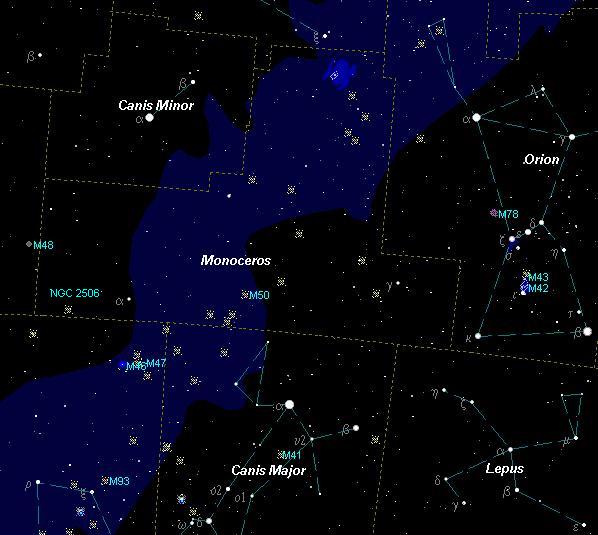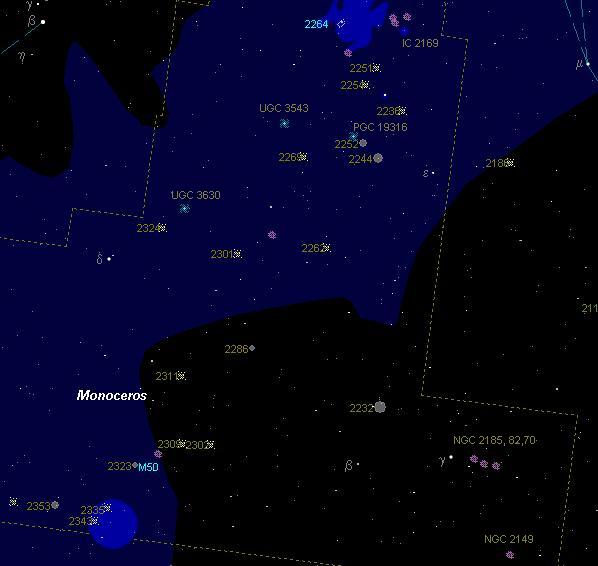A Faint Constellation
The Winter Triangle consists of three bold, bright suns named Betelgeuse, Sirius and Procyon which are the alpha stars belonging to Orion, Canis Major, and Canis Minor respectively. These guideposts are amongst the eighteen brightest stars that make up the winter sky - Taurus, Auriga, Gemini, and the three previously mentioned constellations. However, embedded in this triangle is a dim constellation called Monoceros. In fact, its alpha star only registers magnitude 4.1, but somehow the asterism depicts a Unicorn.
With a total of only 482 square degrees, Monoceros is 35th overall in area. This faint patch of celestial real estate does not possess bright stars to connect the dots as per traditional asterisms and it has a limited choice of objects. We will start with the very impressive combination of objects catalogued as NGC 2264. Here is a great open cluster of stars aka the Christmas Tree Cluster with the Cone Nebula embedded in it. In the same region is the bright variable S Monoceros with the Fox Fur Nebula lying close by.

The majority of objects in Monoceros are open clusters, some impressive while others are not. For instance, at 75 power, NGC 2301 appears is a dense cluster. I counted about 40 suns with a jagged chain of half a dozen bright stars – quite impressive. It measures half a lunar width and is just at naked-eye visibility. On the other side of the coin, NGC 2252 is populated by just a handful of stars and is very loose. The only widely known object in Monoceros is the Rosette Nebula. Its mammoth 80 by 60 arc minute collection of gas is being lit to a reddish tone by the bright cluster NGC 2244 a group of young hot stars, teeming with energy. This would make for a great target for the budding astrophotographer.
M50 shows a lovely triangular structure and glows at magnitude 5.9. Amongst the 50 or so members, a light orangey colour star sort of stands out amongst the rest. Nudging the telescope a degree to the NW you should be able to find NGC 2316 an emission measuring 4 arc minutes wide and NGC 2313, a faint reflection nebula. There are only a handful of galaxies in the 14th magnitude range but UGC 3630 is listed at magnitude 13.6. This elongated galaxy measures 1.6 X .5 arc minutes.

Close to the southern border is NGC 2343. This loose cluster measures a quarter that of the full moon and contains a few bright stars amongst the dozen or so in its group. Moving on the east we come to NGC 2506. Listed as a rich open cluster, don’t let that fool you. Even at magnitude 7.4, I had a bit of difficulty at low power with this one. You will have to increase magnification to enjoy this cluster. Other then the run of the mill open clusters, this constellation has a string of three very difficult faint nebulae. NGC 2185, 2182 and 2170 reside on the far western side of the constellation near the border of Orion. NGC 2170 is the brightest of the trio. Below that is a bright reflective nebula known as NGC 2149.
About 42 arc minutes to the southwest of the constellation’s delta star, is NGC 2346 – a large but faint 11.8 magnitude planetary nebula. This odd-looking planetary was imaged by the Hubble Space Telescope. NGC 2346 lies some 2,000 light-years (ly) from us and measures .3 ly in length. At its center are two closely orbiting stars, of which one was a giant star that consumed the other thus producing this unique pattern. A nebula filter will greatly help to spot this item.
| Object | Type | Magnitude | R.A. | Dec. |
|---|---|---|---|---|
| NGC 2264 | Open Cluster | 3.9 | 06h 41m6.0s | +09° 53' 00" |
| NGC 2301 | Open Cluster | 6.0 | 06h 51m 48.0s | +00° 28' 00" |
| NGC 2252 | Open Cluster | 8.0 | 06h 35m0.0s | +05° 23' 00" |
| Rosette | Emission – reflection Neb |
— | 06h 30m 18.0s | +05° 03' 00" |
| NGC 2313 | Emission Neb | — | 06h 58m0.0s | -07° 57' 00" |
| NGC 2506 | Open Cluster | 7.6 | 08h 00m 12.0s | -10° 47' 00" |
| NGC 2170 | Reflection Nebula | — | 06h 07m 30.0s | -06° 24' 00" |
| NGC 2149 | Reflection Nebula | — | 06h 03m 30.0s | -09° 44' 00" |
| NGC 2346 | Planetary Nebula | 11.8 | 07h 09m 24.0s | -00° 48' 00" |
| NGC 2343 | Open Cluster | 6.7 | 07h 08m 18.0s | -10° 39' 00" |
| NGC 2232 | Open Cluster | 3.9 | 06h 26m 36.0s | -04° 45' 00" |
| NGC 2311 | Open Cluster | 10.0 | 06h 57m 47.9s | -04° 35' 00" |
| NGC 2286 | Open Cluster | 7.2 | 06h 47m 35.9s | -03° 10' 00" |
| UGC 3630 | Elongated Galaxy | 13.6 | 07h 01m3.4s | +01° 54' 37" |
| UGC 3543 | Galaxy | 13.7 | 06h 47m 28.3s | +05° 42' 40" |
The planets Saturn and Mars are running neck and neck in the brightness department with both listed at magnitude 0.25. On March 1st Mars was twice as far as it was on Dec 24th. As March moves on, the red planet will dim slightly as our worlds separate with each passing day. Saturn attained opposition status (closest to the Earth) on Feb 24.
Daylight saving time begins March 9th. Remember to convert the hour difference to Universal Time for your time zone. Spring equinox begins at 1:49 a.m. eastern time on March 20th with day time hours being greater than night hours. And since we are at the equinox with the Sun crossing the celestial equator, the Earth is nicely lined up with the plane of the solar system and its interplanetary dust particles.
For a two week period commencing March 24th until the Moon pops up, you will get the chance to see the Zodiacal light visible in west appearing like a slanted but dim light pillar that climbs about 45 degrees high. Dark skies and the absence of light pollution is a must.
Until next month, clear skies everyone
Gary Boyle
